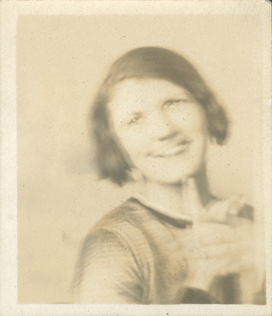A photograph of Zelda from Fitzgerald’s personal album. (MATTHEW J. & ARLYN BRUCCOLI COLLECTION OF F. SCOTT FITZGERALD, UNIVERSITY OF SOUTH CAROLINA LIBRARIES)
There’s one more item on my must-see list: a typed note that seems minor compared to all the Fitzgerald treasures tucked away here in South Carolina. Still, it’s a note that speaks volumes about the speed and force (farce? form?) with which the Fitzgerald Revival took hold in American literary culture. The note, from the fall of 1971, is on Kent State University Press letterhead and it’s from the director of the press, C. Howard Allen, to Edmund Wilson. Allen is writing to Wilson to ask him to blurb a new book about Fitzgerald by scholar Jackson R. Bryer and—who else?—Matthew J. Bruccoli. The book is called F. Scott Fitzgerald in His Own Time and it’s an interesting miscellany of mostly minor pieces by Fitzgerald (short stories written for the school newspaper, book reviews) along with reviews of his own work. Wilson, who by all reports was not a nice man, couldn’t be bothered to write a note on a separate piece of paper. He scrawled this handwritten response at the bottom of Allen’s letter and then must have stuffed the letter into an envelope and sent it back. Wilson’s response, in full, reads:
I am tired to the point of nausea of books on Scott Fitzgerald. Do tell Bruccoli to get interested in some other writer.
Edmund Wilson.45
Edmund Wilson, who’d kick-started the Fitzgerald Revival back in the 1940s with his editions of The Last Tycoon and The Crack-Up, came to realize that he’d created a Frankenstein’s monster. His friend Scott Fitzgerald—whom Wilson had supported but also condescended to during Fitzgerald’s lifetime—had become such a posthumous sensation by the early 1970s that it seemed clear Wilson would forever be in his shadow, instead of the other way round. Wilson may have been “tired to the point of nausea” of books on Fitzgerald, but America—and the world—wanted more editions of Fitzgerald’s work, more biographies, more movies, even more criticism. Everything Fitzgerald wrote was roaring back into print and selling. Fitzgerald was inspiring a new generation of writers who loved his language. Writers as seemingly far removed from Fitzgerald as Norman Mailer, Margaret Atwood, Paul Auster, Don DeLillo, Annie Dillard, John le Carré, and fellow St. Paulite Peanuts cartoonist Charles Schulz were reading and being bowled over by him.46 While working at Time magazine in the 1950s, gonzo journalist Hunter S. Thompson typed out every word of The Great Gatsby and A Farewell to Arms to get a visceral feel for Fitzgerald’s and Hemingway’s style. Another famous, albeit fictional, character who read those two novels in tandem was Holden Caulfield. In The Catcher in the Rye, Holden Caulfield tells us that his older brother, D.B., makes him read A Farewell to Arms (a “phony book” in Holden’s estimation) and The Great Gatsby. “I was crazy about The Great Gatsby,” says Holden. “Old Gatsby. Old sport. That killed me.”47 Holden’s laudatory outburst first occurs in the crucial Fitzgerald Revival year of 1951.
By 1960, The Great Gatsby became the first volume in the paperback Scribner’s Library. In 1961, it was reprinted in a Scribner School Edition intended for high schools, and the Gatsby invasion force was launched. Ever since the 1960s, Scribner’s has continued to repackage Gatsby in textbook series and collections. In classrooms across America and, verily, the world, paperbacks bearing Cugat’s Celestial Eyes (or, more recently, Leonardo DiCaprio’s hooded ones) are marked up with yellow highlighters and scribbled lecture notes: green light = money, Nick = unreliable, and Eckleburg = eyes of God. The Great Gatsby is thrown into lockers along with sweaty gym clothes and hairbrushes; it rides home in backpacks filled with lip gloss and Doritos crumbs and cell phones. It’s downloaded on electronic reading devices, sometimes from illegal websites. (The copyright for The Great Gatsby runs out in 2020.) Students fall asleep over it in their beds, are mildly bored by it in their English classes, and, every once in a while, fall in love with it on first read. Far from disappearing, this odd little novel from 1925 has turned out to be unsinkable.
